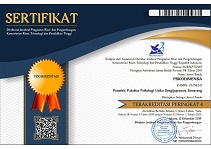Millennials: Do They Need a Hero to Make Their Workplace More Welcoming?
Abstract
Keywords
Full Text:
PDFReferences
Alzyoud, A. A., Othman, S. Z., & Isa, M. F. M. (2015). Examining the role of job resources on work engagement in the academic setting. Asian Social Science, 11(3), 103–110.
doi:10.5539/ass.v11n3p103
Bakker, A. B., & Demerouti, E. (2007). The job demands–resources model: State of the art. Journal of Managerial Psychology, 22(3), 309–328. doi:10.1108/02683940710733115
Bakker, A. B., & Demerouti, E. (2008). Towards a model of work engagement. Career Development International, 13(3), 209–223. doi:10.1108/13620430810870476
Bandura, A. (1994). Self-efficacy. In V. S. Ramachaudran (Ed.), Encyclopedia of human behavior (Vol. 4, pp. 71–81). New York, NY: Academic Press.
Carver, C. S., Scheier, M. F., & Segerstrom, S. C. (2010). Optimism. Clinical Psychology Review, 30(7), 879–889. doi:10.1016/j.cpr.2010.01.006
Chou, S. Y. (2012). Millennials in the workplace: A conceptual analysis of millennials’ leadership and followership styles. International Journal of Human Resource Studies, 2(2), 71–83. doi:10.5296/ijhrs.v2i2.1568
Coetzer, C. F., & Rothmann, S. (2007). Job demands, job resources and work engagement of employees in a manufacturing organisation. Southern African Business Review, 11(3), 17–32. Retrieved from http://hdl.handle.net/10520/EJC92864
Demerouti, E., & Bakker, A. B. (2011). The job demands–resources model: Challenges for future research. SA Journal of Industrial Psychology, 37(2), 1–9. doi:10.4102/sajip.v37i2.974
Demerouti, E., Bakker, A. B., Nachreiner, F., & Schaufeli, W. B. (2001). The job demands–resources model of burnout. Journal of Applied Psychology, 86(3), 499–512.
doi:10.1037/0021-9010.86.3.499
De Waal, J. J., & Pienaar, J. (2013). Towards understanding causality between work engagement and psychological capital. SA Journal of Industrial Psychology, 39(2), 1–10. doi:10.4102/sajip.v39i2.1113
De Waal, J.J.P. (2011). The role of Positve Organisational Behaviour in employee self development and organisatonal outcomes. Unpublished doctoral thesis), NorthWest University, Potchefstroom, South Africa.
Farndale, E., & Murrer, I. (2015). Job resources and employee engagement: A cross-national study. Journal of Managerial Psychology, 30(5), 610–626.
doi:10.1108/JMP-09-2013-0318
Hallberg, U. E., & Schaufeli, W. B. (2006). “Same same” but different? Can work engagement be discriminated from job involvement and organizational commitment? European Psychologist, 11(2), 119–127. doi:10.1027/1016-9040.11.2.119
Harter, J. K., Schmidt, F. L., & Hayes, T. L. (2002). Business-unit-level relationship between employee satisfaction, employee engagement, and business outcomes: A meta-analysis. Journal of Applied Psychology, 87(2), 268–279. doi:10.1037//0021-9010.87.2.268
Hayes, F. H. (2018). Introduction to mediation, moderation, and conditional process analysis: A regression-based approach (2nd ed.). New York, NY: Guilford Press.
Kahn, W. A. (1990). Psychological conditions of personal engagement and disengagement at work. Academy of Management Journal, 33(4), 692–724. doi:10.5465/256287
Karthikeyan, C. (2017). A qualitative study on managing millennial mindsets: Awaiting challenges for HR strategists and recruiters. International Journal of Innovative Research in Engineering & Management, 4(1), 601–609. doi:10.21276/ijirem.2017.4.1.10
Kopertyńska, M. W., & Kmiotek, K. (2015). Engagement of employees of generation Y — theoretical issues and research experience. Argumenta Oeconomica, 2(35), 185–201.
doi:10.15611/aoe.2015.2.10
Langenhoven, A. (2015). How job demands and resources predict burnout, engagement and intention to quit in call centres (MCom Thesis, Stellenbosch University ). Retrieved from SUNScholar Research Repository.
Luthans, F., Avey, J. B., Avolio, B. J., Norman, S. M., & Combs, G. M. (2006). Psychological capital development: Toward a micro-intervention. Journal of Organizational Behavior, 27(3), 387–393. doi:10.1002/job.373
Luthans, F., Avolio, B. J., Avey, J. B., & Norman, S. M. (2007a). Positive psychological capital: Measurement and relationship with performance and satisfaction. Personnel Psychology, 60(3), 541–572. doi:10.1111/j.1744-6570.2007.00083.x
Luthans, F., Youssef, C. M., & Avolio, B. J. (2007b). Psychological capital: Developing the human competitive edge. New York, NY: Oxford University Press.
Lyubomirsky, S., King, L., & Diener, E. (2005). The benefits of frequent positive affect: Does happiness lead to success? Psychological Bulletin, 131(6), 803–855.
doi:10.1037/0033-2909.131.6.803
Mauno, S., Kinnunen, U., & Ruokolainen, M. (2007). Job demands and resources as antecedents of work engagement: A longitudinal study. Journal of Vocational Behavior, 70(1), 149–171. doi:10.1016/j.jvb.2006.09.002
Martin, C. A. (2005). From high maintenance to high productivity: What managers need to know about Generation Y. Industrial and Commercial Training, 37(1), 39–44.
doi:10.1108/00197850510699965
Morgeson, F. P., & Humphrey, S. E. (2006). The Work Design Questionnaire (WDQ): Developing and validating a comprehensive measure for assessing job design and the nature of work. Journal of Applied Psychology, 91(6), 1321–1339.
doi:10.1037/0021-9010.91.6.1321
Namita. (2014) Work-life balance in India — the key driver of employee engagement. International Journal of Management and Commerce Innovations, 2(1), 103–109. Retrieved from www.researchpublish.com/download.php?/WORK-LIFE%20BALANCE%20IN%20INDIA-413.pdf
Podsakoff, P. M., MacKenzie, S. B., Lee, J.-Y., & Podsakoff, N. P. (2003). Common method biases in behavioral research: A critical review of the literature and recommended remedies. Journal of Applied Psychology, 88(5), 879–903.
doi: 10.1037/0021-9010.88.5.879
Saks, A. M. (2006). Antecedents and consequences of employee engagement. Journal of Managerial Psychology, 21(7), 600-619. doi: 10.1108/02683940610690169
Sanner-Stiehr, E., & Vandermause, R. K. (2017). Can’t we all just get along? A dual-theory approach to understanding and managing the multigenerational workplace. Journal of Organizational Psychology, 17(2), 103–110. Retrieved from https://www.vumc.org/faculty/files/faculty/public_files/ConflictRes4.pdf
Schaufeli, W. B., & Bakker, A. B. (2004). Job demands, job resources, and their relationship with burnout and engagement: A multi-sample study. Journal of Organizational Behavior, 25(3), 293–315. doi:10.1002/job.248
Schaufeli, W. B., Bakker, A. B., & Salanova, M. (2006). The measurement of work engagement with a short questionnaire: A cross-national study. Educational and Psychological Measurement, 66(4), 701–716. doi: 10.1177/0013164405282471
Schaufeli, W. B., Salanova, M., González-romá, V., & Bakker, A. B. (2002). The measurement of engagement and burnout: A two sample confirmatory factor analytic approach. Journal of Happiness Studies, 3(1), 71–92. doi:10.1023/A:1015630930326
Snyder, C. R. (2002). Hope theory: Rainbows in the mind. Psychological Inquiry, 13(4), 249–275. Retrieved from http://www.jstor.org/stable/1448867
Southwick, S. M., Bonanno, G. A., Masten, A. S., Panter-Brick, C., &
Yehuda, R. (2014). Resilience definitions, theory, and challenges: Interdisciplinary perspectives. European Journal of
Psychotraumatology, 5, 1–14. doi:10.3402/ejpt.v5.25338
Wollard, K. K., & Shuck, B. (2011). Antecedents to employee engagement: A structured review of the literature. Advances in Developing Human Resources, 13(4), 429–446.
doi:10.1177/1523422311431220
Xanthopoulou, D., Bakker, A. B., Demerouti, E., & Schaufeli, W. B. (2007). The role of personal resources in the job demands–resources model. International Journal of Stress Management, 14(2), 121–141. doi:10.1037/1072-5245.14.2.121
Xanthopoulou, D., Bakker, A. B., Demerouti, E., & Schaufeli, W. B. (2009). Reciprocal relationships between job resources, personal resources, and work engagement. Journal of Vocational Behavior, 74(3), 235–244. doi:10.1016/j.jvb.2008.11.003
Youssef-Morgan, C. M., & Luthans, F. (2015). Psychological capital and well-being. Stress and Health, 31(3), 180–188. doi:10.1002/smi.2623
DOI: https://doi.org/10.24167/psidim.v17i2.1550
Print ISSN : 1411-6073 | online ISSN : 2579-6321 View My Stats

This work is licensed under a Creative Commons Attribution 4.0 International License.





















